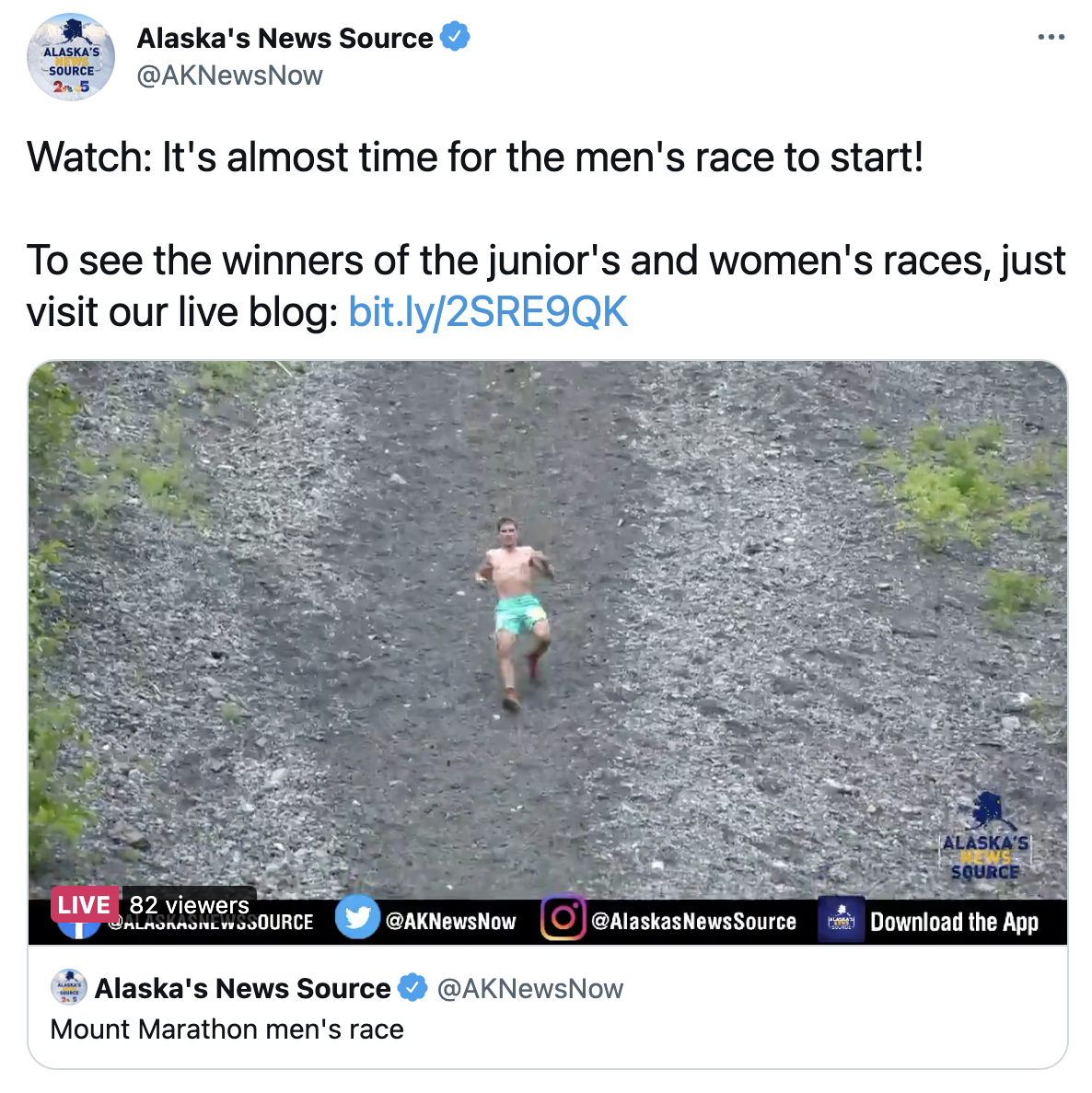
Men’s race
Most athletes pay their dues as they work their way up the results list for Mount Marathon, the grueling 5-kilometer, 3,000-foot-gain out-and-back race in Seward, Alaska, that dates to 1915. There is no substitute for experience on the technical course, and most people need to get their rookie run out of the way before they can even think of challenging for the overall victory in subsequent times on the mountain.
David Norris is not most athletes.
Racing on an overcast Wednesday afternoon, Norris lodged his third-ever start in what is believed to be the country’s oldest mountain race. Roughly 43 minutes later, he had claimed his third-ever victory, continuing his winning ways as he ran down Fourth Avenue in downtown Seward before a crowd of thousands.
Norris’s time of 43:27, though well off his course record of 41:26, was still just outside the all-time top-10 list for a race that has was first held in World War I. He probably would have cracked the top 10 if he hadn’t slowed to high five children lining the final few blocks.
Norris’s aerobic fitness, even for a world-class cross-country skier, is superb. In June he lowered his own course record on the uphill-only Bird Ridge hill climb (3 miles, 3,400 vertical feet) to a frankly staggering 35:40, well over a minute ahead of anyone not named David Norris on a course that has been covered by virtually every Alaska-based nordic athlete in the past three decades.
On Wednesday, Norris used these skills to hit the halfway point of the climb in 18:25, already well ahead of Canadian skier Sam Hendry (second at this year’s NCAA Championships for University of Utah) in 18:59 and pro trail runner Darren Thomas in 19:21. By the turnaround, at 2,974 feet at a false summit midway up the mountain, the gap had grown to nearly two minutes: Norris in 31:54, Thomas in 33:48, and Hendry in 34:27.

Hendry overtook Thomas on the descent to move back into second, as the athletes plummeted nearly 3,000 feet in less than three kilometers, but Norris padded his lead as he ran alone to the finish. The final podium was David Norris, 43:27; Sam Hendry, 46:00; and Darren Thomas, 46:09, according to unofficial live results. Fourth went to Michael Connelly, a bronze medalist at 2019 Youth World Skyrunning Championships, and sixth to Lars Arneson, who holds the unsupported Grand Canyon Rim-to-Rim FKT, reflecting the depth of the Alaska mountain running community. (Another Salomon-sponsored athlete from Outside was seventh.)
“It feels good. I’m stoked to be back” at this race, a composed Norris told local television broadcasters after taking the time to put on a dry shirt and drink some water, looking barely winded and conducting his post-race interview while the rest of the podium was still on the course.
“I felt good,” he continued. “The mud [on the first part of the ascent] was super-slick, so I was just being patient till we got out of the trees. Then I figured, use the fitness where the footing’s good.”
“It’s great to see that we’re able to pull this off” again, Norris said, after the 2020 race was cancelled due to Covid and the 2019 race was marred by poor air quality due to wildfire smoke. “It’s fun to be out here with so many good friends, and the Alaskans who are psyched to run up a mountain.”
So what’s next, Norris was asked. “Now it’s just rollerski time trial time,” he said, as he looks ahead to this winter’s Olympics.
Norris holds the all-time course record for Mt. Marathon, 41:26, as well as the third-fastest time. Second place on the all-time list is held by Kílian Jornet (yes, that Kílian Jornet), from 2015. Other notable skiers in the all-time top-10 include former UAA and APU skier Eric Strabel, and 1988 Winter Olympian Bill Spencer.
Women’s race
Rosie Frankowski’s race began a lot like Norris’s: she was first by nearly a minute at the halfway point of the climb, and first by nearly two minutes at the top. Unfortunately for the APU skier and Olympic hopeful, the finish line is back down at sea level – and no one else in the top five needed to hold back a little on the descent to avoid incurring an injury in the run-up to the Beijing Olympics. Frankowski would ultimately finish fourth this year, after taking a notably non-aggressive line on the descent in 2018 to slip from first to seventh.

The uphill, however, was all Frankowski. She already had a gap of several meters by the base of the cliffs roughly a half-kilometer into the race, which she consistently stretched on the near-vertical climb through densely humid undergrowth. She emerged onto the stark shale slopes of the upper mountain to reach the halfway point of the climb in 20:19, substantially ahead of Ruby Lundquist (21:17), Hannah Lafleur (21:44), and Christy Marvin (21:45). It was more of the same at the turnaround point: Frankowski first in 37:06, then a gap of nearly two minutes to Lindquist (38:57) and three minutes to Marvin and Lafleur (39:38 and 39:40).
Frankowski’s ascent tied her 2018 effort for the third-fastest uphill since at least 2006, according to available records.
“The uphill was great,” Frankowski emailed. “It was definitely a bit slippery in the first half from recent rain and the top half was quite a bit softer than in 2018. I had quite a few slips where I had to catch myself with my hands, but I never did a total belly slide. Fog rolled in right when I was near the top and inexperience on the mountain made me think I had a lot further to go than I did, so I was surprised to see the American flag at the top and kind of bummed out that I didn’t put in a last uphill surge which I was waiting to do to run under 37 minutes.”
The descent, however, is not Frankowski’s forte, and she may have wished to exercise additional caution as a non-U.S. Ski Team athlete going into an Olympic year. Lafleur unleashed the day’s fastest downhill by a substantial margin, 11:44, to overtake all three athletes in front of her and win in 51:24. Lindquist was close behind in 51:38. Marvin, a 40-year-old mother of three, rounded out the podium in 52:21. Frankowski reached the finish, apparently uninjured, in 52:56.
In 2018, Frankowski notched the day’s 92nd-fastest time on the descent. She improved considerably this year, taking off nearly four minutes on the downhill to rank a healthy 24th among downhillers, out of roughly 230 women total, helping her to a fourth-place finish.
Other nordic skiers in this year’s top 10 included former Dartmouth skier (and current Salomon-sponsored pro trail runner) Taryn Hunt-Smith in eighth and current USST D-Team athlete Kendall Kramer in ninth. Nordic skiers in the all-time top 10 include Morgan Arritola in seventh and Jessica Yeaton in ninth.
Results: Men | Women | Girls | Boys
From the archives: Here’s some additional background on this only-in-Alaska race from FasterSkier’s article on the 2018 race won by Norris and Yeaton:
Here’s the race’s origin story, according to the official website:
“According to folklore, the tradition of the Mount Marathon Race began when two sourdoughs argued about the possibility of climbing and descending the mountain in less than an hour. ‘Impossible’ one said. To settle the argument, and the resulting wager, a race was held, with the loser to furnish drinks for the crowd. At the same time, enterprising merchants put up a suit of clothes and other attractions for the winner and proposed the race take place on a holiday – why not the 4th of July? The optimistic sourdough lost his bet. The winning racer took one hour and two minutes.”
The race was first formally contested in 1915, with a winning time of 1:02:02. There were no races held in the early 1920s, the mid-1930s, and for one year during World War II. The race has been held every year since 1943, always on the fourth of July. 2018 marks the 91st running of the race. [The 2019 juniors race would be cancelled due to poor air quality, and the 2020 race cancelled due to Covid.]
The first official women finishers were in 1963, nine years before women were officially allowed in the Boston Marathon and 21 years before women were allowed to race distances over 1,500 meters at the Summer Olympics.
Notable past Mount Marathon champions who were also skiers include, in reverse chronological order, Holly Brooks, Kikkan Randall, Nina Kemppel, Lynn Galanes, and Betsy Haines (Randall’s aunt). Notable male Mount Marathon champions who were also skiers include Scott Patterson, David Norris, Eric Strabel, Trond Flagstad, Toby Schwörer, Todd Boonstra, Bill Spencer, Jim Renkert, Tom Besh, and Sven Johanson. Kílian Jornet, who won in 2015 and held the course record before David Norris happened, may merit honorable mention as a ski mountaineer.

The race’s course description page reassures racers, “Mount Marathon is not quite as steep as has been previously reported. The true steepness – from the base of the mountain to the lip of the mountain just before the turnaround rock – averages 34 degrees. That figure was calculated using GPS data from several racers. Excluding the road approach, the vertical gain is about 2,675 feet in 0.9 miles.”
Max King, a professional runner who has raced all over the world for nearly twenty years, told Clint McCool that he “had never raced anything so steep, and had never come down anything so fast,” according to McCool’s comments on the broadcast.
Outside magazine has called Mount Marathon “the toughest 5k on the planet.” It is undeniably the most famous footrace in Alaska, and the second most famous athletic event anywhere in the state, behind only the Iditarod Trail Sled Dog Race. It has grown from its humble origins to a yearly spectacle that is sometimes covered by helicopter and drone and broadcast live on local network television, as well as online.
Gavin Kentch
Gavin Kentch wrote for FasterSkier from 2016–2022. He has a cat named Marit.



